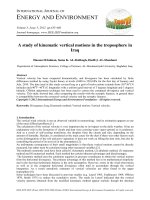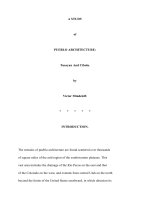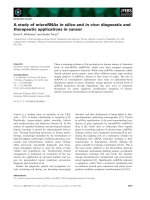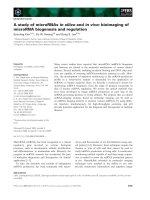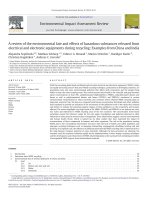A STUDY of PUEBLO ARCHITECTURE:Tusayan And Cibola docx
Bạn đang xem bản rút gọn của tài liệu. Xem và tải ngay bản đầy đủ của tài liệu tại đây (1023.23 KB, 479 trang )
A STUDY
of
PUEBLO ARCHITECTURE:
Tusayan And Cibola.
by
Victor Mindeleff.
* * * * *
INTRODUCTION.
The remains of pueblo architecture are found scattered over thousands
of square miles of the arid region of the southwestern plateaus. This
vast area includes the drainage of the Rio Pecos on the east and that
of the Colorado on the west, and extends from central Utah on the north
beyond the limits of the United States southward, in which direction its
boundaries are still undefined.
The descendants of those who at various times built these stone
villages are few in number and inhabit about thirty pueblos distributed
irregularly over parts of the region formerly occupied. Of these the
greater number are scattered along the upper course of the Rio Grande
and its tributaries in New Mexico; a few of them, comprised within the
ancient provinces of Cibola and Tusayan, are located within the
drainage of the Little Colorado. From the time of the earliest Spanish
expeditions into the country to the present day, a period covering more
than three centuries, the former province has been often visited by
whites, but the remoteness of Tusayan and the arid and forbidding
character of its surroundings have caused its more complete isolation.
The architecture of this district exhibits a close adherence to
aboriginal practices, still bears the marked impress of its development
under the exacting conditions of an arid environment, and is but slowly
yielding to the influence of foreign ideas.
The present study of the architecture of Tusayan and Cibola embraces all
of the inhabited pueblos of those provinces, and includes a number of
the ruins traditionally connected with them. It will be observed by
reference to the map that the area embraced in these provinces comprises
but a small portion of the vast region over which pueblo culture once
extended.
This study is designed to be followed by a similar study of two typical
groups of ruins, viz, that of Canyon de Chelly, in northeastern Arizona,
and that of the Chaco Canyon, of New Mexico; but it has been necessary
for the writer to make occasional reference to these ruins in the
present paper, both in the discussion of general arrangement and
characteristic ground plans, embodied in Chapters II and III and in the
comparison by constructional details treated in Chapter IV, in order
to define clearly the relations of the various features of pueblo
architecture. They belong to the same pueblo system illustrated by the
villages of Tusayan and Cibola, and with the Canyon de Chelly group
there is even some trace of traditional connection, as is set forth by
Mr. Stephen in Chapter I. The more detailed studies of these ruins, to
be published later, together with the material embodied in the present
paper, will, it is thought, furnish a record of the principal
characteristics of an important type of primitive architecture, which,
under the influence of the arid environment of the southwestern
plateaus, has developed from the rude lodge into the many-storied
house of rectangular rooms. Indications of some of the steps of this
development are traceable even in the architecture of the present day.
The pueblo of Zuñi was surveyed by the writer in the autumn of 1881
with a view to procuring the necessary data for the construction of a
large-scale model of this pueblo. For this reason the work afforded a
record of external features only.
The modern pueblos of Tusayan were similarly surveyed in the following
season (1882-'83), the plans being supplemented by photographs, from
which many of the illustrations accompanying this paper have been drawn.
The ruin of Awatubi was also included in the work of this season.
In the autumn of 1885 many of the ruined pueblos of Tusayan were
surveyed and examined. It was during this season's work that the details
of the kiva construction, embodied in the last chapter of this paper,
were studied, together with interior details of the dwellings. It was in
the latter part of this season that the farming pueblos of Cibola were
surveyed and photographed.
The Tusayan farming pueblo of Moen-kopi and a number of the ruins in the
province were surveyed and studied in the early part of the season of
1887-'88, the latter portion of which season was principally devoted to
an examination of the Chaco ruins in New Mexico.
In the prosecution of the field work above outlined the author has been
greatly indebted to the efficient assistance and hearty cooperation of
Mr. Cosmos Mindeleff, by whom nearly all the pueblos illustrated, with
the exception of Zuñi, have been surveyed and platted.
The plans obtained have involved much careful work with surveying
instruments, and have all been so platted as faithfully to record the
minute variations from geometric forms which are so characteristic of
the pueblo work, but which have usually been ignored in the hastily
prepared sketch plans that have at times appeared. In consequence of
the necessary omission of just such information in hastily drawn plans,
erroneous impressions have been given regarding the degree of skill to
which the pueblo peoples had attained in the planning and building of
their villages. In the general distribution of the houses, and in the
alignment and arrangement of their walls, as indicated in the plans
shown in Chapters II and III, an absence of high architectural
attainment is found, which is entirely in keeping with the lack of skill
apparent in many of the constructional devices shown in Chapter IV.
[Illustration: Plate II. Old Mashongnavi, plan.]
In preparing this paper for publication Mr. Cosmos Mindeleff has
rendered much assistance in the revision of manuscript, and in the
preparation of some of the final drawings of ground plans; on him has
also fallen the compilation and arrangement of Mr. A. M. Stephen's
traditionary material from Tusayan, embraced in the first chapter of the
paper.
This latter material is of special interest in a study of the pueblos as
indicating some of the conditions under which this architectural type
was developed, and it appropriately introduces the more purely
architectural study by the author.
Such traditions must be used as history with the utmost caution,
and only for events that are very recent. Time relations are often
hopelessly confused and the narratives are greatly incumbered with
mythologic details. But while so barren in definite information, these
traditions are of the greatest value, often through their merely
incidental allusions, in presenting to our minds a picture of the
conditions under which the repeated migrations of the pueblo builders
took place.
The development of architecture among the Pueblo Indians was
comparatively rapid and is largely attributable to frequent changes,
migrations, and movements of the people as described in Mr. Stephen's
account. These changes were due to a variety of causes, such as disease,
death, the frequent warfare carried on between different tribes and
branches of the builders, and the hostility of outside tribes; but a
most potent factor was certainly the inhospitable character of their
environment. The disappearance of some venerated spring during an
unusually dry season would be taken as a sign of the disfavor of the
gods, and, in spite of the massive character of the buildings, would
lead to the migration of the people to a more favorable spot. The
traditions of the Zuñis, as well as those of the Tusayan, frequently
refer to such migrations. At times tribes split up and separate, and
again phratries or distant groups meet and band together. It is
remarkable that the substantial character of the architecture should
persist through such long series of compulsory removals, but while the
builders were held together by the necessity for defense against their
wilder neighbors or against each other, this strong defensive motive
would perpetuate the laborious type of construction. Such conditions
would contribute to the rapid development of the building art.
CHAPTER I.
TRADITIONAL HISTORY OF TUSAYAN.
EXPLANATORY.
In this chapter[1] is presented a summary of the traditions of the
Tusayan, a number of which were collected from old men, from Walpi on
the east to Moen-kopi on the west. A tradition varies much with the
tribe and the individual; an authoritative statement of the current
tradition on any point could be made only with a complete knowledge of
all traditions extant. Such knowledge is not possessed by any one man,
and the material included in this chapter is presented simply as a
summary of the traditions secured.
[Footnote 1: This chapter is compiled by Cosmos Mindeleff from
material collected by A. M. Stephen.]
The material was collected by Mr. A. M. Stephen, of Keam's Canyon,
Arizona, who has enjoyed unusual facilities for the work, having lived
for a number of years past in Tusayan and possessed the confidence
of the principal priests a very necessary condition in work of
this character. Though far from complete, this summary is a more
comprehensive presentation of the traditionary history of these people
than has heretofore been published.
SUMMARY OF TRADITIONS.
The creation myths of the Tusayan differ widely, but none of them
designate the region now occupied as the place of their genesis. These
people are socially divided into family groups called wi´ngwu, the
descendants of sisters, and groups of wi´ngwu tracing descent from the
same female ancestor, and having a common totem called my´umu. Each of
these totemic groups preserves a creation myth, carrying in its details
special reference to themselves; but all of them claim a common origin
in the interior of the earth, although the place of emergence to the
surface is set in widely separated localities. They all agree in
maintaining this to be the fourth plane on which mankind has existed. In
the beginning all men lived together in the lowest depths, in a region
of darkness and moisture; their bodies were misshaped and horrible, and
they suffered great misery, moaning and bewailing continually. Through
the intervention of Myúingwa (a vague conception known as the god of the
interior) and of Baholikonga (a crested serpent of enormous size, the
genius of water), the "old men" obtained a seed from which sprang a
magic growth of cane. It penetrated through a crevice in the roof
overhead and mankind climbed to a higher plane. A dim light appeared in
this stage and vegetation was produced. Another magic growth of cane
afforded the means of rising to a still higher plane on which the light
was brighter; vegetation was reproduced and the animal kingdom was
created. The final ascent to this present, or fourth plane, was effected
by similar magic growths and was led by mythic twins, according to some
of the myths, by climbing a great pine tree, in others by climbing the
cane, _Phragmites communis_, the alternate leaves of which afforded
steps as of a ladder, and in still others it is said to have been a
rush, through the interior of which the people passed up to the surface.
The twins sang as they pulled the people out, and when their song was
ended no more were allowed to come; and hence, many more were left below
than were permitted to come above; but the outlet through which mankind
came has never been closed, and Myu´ingwa sends through it the germs of
all living things. It is still symbolized by the peculiar construction
of the hatchway of the kiva and in the designs on the sand altars in
these underground chambers, by the unconnected circle painted on pottery
and by devices on basketry and other textile fabrics.
[Illustration: Plate III. General view of Awatubi.]
All the people that were permitted to come to the surface were collected
and the different families of men were arranged together. This was done
under the direction of twins, who are called Pekónghoya, the younger one
being distinguished by the term Balíngahoya, the Echo. They were
assisted by their grandmother, Kóhkyang wúhti, the Spider woman, and
these appear in varying guises in many of the myths and legends. They
instructed the people in divers modes of life to dwell on mountain or on
plain, to build lodges, or huts, or windbreaks. They distributed
appropriate gifts among them and assigned each a pathway, and so the
various families of mankind were dispersed over the earth's surface.
The Hopituh,[2] after being taught to build stone houses, were also
divided, and the different divisions took separate paths. The legends
indicate a long period of extensive migrations in separate communities;
the groups came to Tusayan at different times and from different
directions, but the people of all the villages concur in designating the
Snake people as the first occupants of the region. The eldest member of
that nyumu tells a curious legend of their migration from which the
following is quoted:
At the general dispersal my people lived in snake skins, each family
occupying a separate snake skin bag, and all were hung on the end of
a rainbow, which swung around until the end touched Navajo Mountain,
where the bags dropped from it; and wherever a bag dropped, there
was their house. After they arranged their bags they came out from
them as men and women, and they then, built a stone house which had
five sides. [The story here relates the adventures of a mythic Snake
Youth, who brought back a strange woman who gave birth to
rattlesnakes; these bit the people and compelled them to migrate.] A
brilliant star arose in the southeast, which would shine for a while
and then disappear. The old men said, "Beneath that star there must
be people," so they determined to travel toward it. They cut a staff
and set it in the ground and watched till the star reached its top,
then they started and traveled as long as the star shone; when it
disappeared they halted. But the star did not shine every night, for
sometimes many years elapsed before it appeared again. When this
occurred, our people built houses during their halt; they built both
round and square houses, and all the ruins between here and Navajo
Mountain mark the places where our people lived. They waited till
the star came to the top of the staff again, then they moved on, but
many people were left in those houses and they followed afterward at
various times. When our people reached Wipho (a spring a few miles
north from Walpi) the star disappeared and has never been seen
since. They built a house there and after a time Másauwu (the god of
the face of the earth) came and compelled them to move farther down
the valley, to a point about half way between the East and Middle
Mesa, and there they stayed many plantings. One time the old men
were assembled and Másauwu came among them, looking like a horrible
skeleton, and his bones rattling dreadfully. He menaced them with
awful gestures, and lifted off his fleshless head and thrust it into
their faces; but he could not frighten them. So he said, "I have
lost my wager; all that I have is yours; ask for anything you want
and I will give it to you." At that time our people's house was
beside the water course, and Másauwu said, "Why are you sitting here
in the mud? Go up yonder where it is dry." So they went across to
the low, sandy terrace on the west side of the mesa, near the point,
and built a house and lived there. Again the old men were assembled
and two demons came among them and the old men took the great Baho
and the nwelas and chased them away. When they were returning, and
were not far north from, their village, they met the Lenbaki
(Cane-Flute, a religious society still maintained) of the Horn
family. The old men would not allow them to come in until Másauwu
appeared and declared them to be good Hopituh. So they built houses
adjoining ours and that made a fine, large village. Then other
Hopituh came in from time to time, and our people would say, "Build
here, or build there," and portioned the land among the new comers.
[Footnote 2: The term by which the Tusayan Indians proper designate
themselves. This term does not include the inhabitants of the
village of Tewa or Hano, who are called Hanomuh.]
The site of the first Snake house in the valley, mentioned in the
foregoing legend, is now barely to be discerned, and the people refuse
to point out the exact spot. It is held as a place of votive offerings
during the ceremony of the Snake dance, and, as its name, Bátni,
implies, certain rain-fetiches are deposited there in small jars buried
in the ground. The site of the village next occupied can be quite easily
distinguished, and is now called Kwetcap tutwi, ash heap terrace, and
this was the village to which the name Walpi was first applied a term
meaning the place at the notched mesa, in allusion to a broad gap in the
stratum of sandstone on the summit of the mesa, and by which it can be
distinguished from a great distance. The ground plan of this early Walpi
can still be partly traced, indicating the former existence of an
extensive village of clustering, little-roomed houses, with thick walls
constructed of small stones.
The advent of the Lenbaki is still commemorated by a biennial ceremony,
and is celebrated on the year alternating with their other biennial
ceremony, the Snake dance.
The Horn people, to which the Lenbaki belonged, have a legend of coming
from a mountain range in the east.
Its peaks were always snow covered, and the trees were always green.
From the hillside the plains were seen, over which roamed the deer,
the antelope, and the bison, feeding on never-failing grasses.
Twining through these plains were streams of bright water, beautiful
to look upon. A place where none but those who were of our people
ever gained access.
[Illustration: Plate IV. Awatubi (Talla-Hogan), plan.]
This description suggests some region of the head-waters of the Rio
Grande. Like the Snake people, they tell of a protracted migration, not
of continuous travel, for they remained for many seasons in one place,
where they would plant and build permanent houses. One of these halting
places is described as a canyon with high, steep walls, in which was a
flowing stream; this, it is said, was the Tségi (the Navajo name for
Canyon de Chelly). Here they built a large house in a cavernous recess,
high up in the canyon wall. They tell of devoting two years[3] to ladder
making and cutting and pecking shallow holes up the steep rocky side by
which to mount to the cavern, and three years more were employed in
building the house. While this work was in progress part of the men were
planting gardens, and the women and children were gathering stones. But
no adequate reason is given for thus toiling to fit this impracticable
site for occupation; the footprints of Másauwu, which they were
following, led them there.
[Footnote 3: The term yasuna, translated here as "year," is of
rather indefinite significance; it sometimes means thirteen moons
and in other instances much longer periods.]
The legend goes on to tell that after they had lived there for a long
time a stranger happened to stray in their vicinity, who proved to be a
Hopituh, and said that he lived in the south. After some stay he left
and was accompanied by a party of the "Horn," who were to visit the land
occupied by their kindred Hopituh and return with an account of them;
but they never came back. After waiting a long time another band was
sent, who returned and said that the first emissaries had found wives
and had built houses on the brink of a beautiful canyon, not far from
the other Hopituh dwellings. After this many of the Horns grew
dissatisfied with their cavern home, dissensions arose, they left their
home, and finally they reached Tusayan. They lived at first in one of
the canyons east of the villages, in the vicinity of Keam's Canyon, and
some of the numerous ruins on its brink mark the sites of their early
houses. There seems to be no legend distinctly attaching any particular
ruin to the Horn people, although there is little doubt that the Snake
and the Horn were the two first peoples who came to the neighborhood of
the present villages. The Bear people were the next, but they arrived as
separate branches, and from opposite directions, although of the same
Hopituh stock. It has been impossible to obtain directly the legend of
the Bears from the west. The story of the Bears from the east tells of
encountering the Fire people, then living about 25 miles east from
Walpi; but these are now extinct, and nearly all that is known of them
is told in the Bear legend, the gist of which is as follows:
The Bears originally lived among the mountains of the east, not far
distant from the Horns. Continual quarrels with neighboring villages
brought on actual fighting, and the Bears left that region and traveled
westward. As with all the other people, they halted, built houses, and
planted, remaining stationary for a long while; this occurred at
different places along their route.
A portion of these people had wings, and they flew in advance to survey
the land, and when the main body were traversing an arid region they
found water for them. Another portion had claws with which they dug
edible roots, and they could also use them for scratching hand and foot
holes in the face of a steep cliff. Others had hoofs, and these carried
the heaviest burdens; and some had balls of magic spider web, which they
could use on occasion for ropes, and they could also spread the web and
use it as a mantle, rendering the wearer invisible when he apprehended
danger.
They too came to the Tségi (Canyon de Chelly), where they found houses
but no people, and they also built houses there. While living there a
rupture occurred, a portion of them separating and going far to the
westward. These seceding bands are probably that branch of the Bears who
claim their origin in the west. Some time after this, but how long after
is not known, a plague visited the canyon, and the greater portion of
the people moved away, but leaving numbers who chose to remain. They
crossed the Chinli valley and halted for a short time at a place a short
distance northeast from Great Willow water ("Eighteen Mile Spring").
They did not remain there long, however, but moved a few miles farther
west, to a place occupied by the Fire people who lived in a large oval
house. The ruin of this house still stands, the walls from 5 to 8 feet
high, and remarkable from the large-sized blocks of stone used in their
construction; it is still known to the Hopituh as Tebvwúki, the
Fire-house. Here some fighting occurred, and the Bears moved westward
again to the head of Antelope (Jeditoh) Canyon, about 4 miles from
Keam's Canyon and about 15 miles east from Walpi. They built there a
rambling cluster of small-roomed houses, of which the ground plan has
now become almost obliterated. This ruin is called by the Hopituh "the
ruin at the place of wild gourds." They seem to have occupied this
neighborhood for a considerable period, as mention is made of two or
three segregations, when groups of families moved a few miles away and
built similar house clusters on the brink of that canyon.
[Illustration: Plate V. Standing walls of Awatubi.]
The Fire-people, who, some say, were of the Horn people, must have
abandoned their dwelling at the Oval House or must have been driven out
at the time of their conflict with the Bears, and seem to have traveled
directly to the neighborhood of Walpi. The Snakes allotted them a place
to build in the valley on the east side of the mesa, and about two miles
north from the gap. A ridge of rocky knolls and sand dunes lies at the
foot of the mesa here, and close to the main cliff is a spring. There
are two prominent knolls about 400 yards apart and the summits of these
are covered with traces of house walls; also portions of walls can be
discerned on all the intervening hummocks. The place is known as
Sikyátki, the yellow-house, from the color of the sandstone of which the
houses were built. These and other fragmentary bits have walls not over
a foot thick, built of small stones dressed by rubbing, and all laid in
mud; the inside of the walls also show a smooth coating of mud plaster.
The dimensions of the rooms are very small, the largest measuring 9½
feet long, by 4½ feet wide. It is improbable that any of these
structures were over two stories high, and many of them were built in
excavated places around the rocky summits of the knolls. In these
instances no rear wall was built; the partition walls, radiating at
irregular angles, abut against the rock itself. Still, the great numbers
of these houses, small as they were, must have been far more than the
Fire-people could have required, for the oval house which they abandoned
measures not more than a hundred feet by fifty. Probably other incoming
gentes, of whom no story has been preserved, had also the ill fate to
build there, for the Walpi people afterward slew all its inhabitants.
There is little or no detail in the legends of the Bear people as to
their life in Antelope Canyon; they can now distinguish only one ruin
with certainty as having been occupied by their ancestors, while to all
the other ruins fanciful names have been applied. Nor is there any
special cause mentioned for abandoning their dwellings there; probably,
however, a sufficient reason was the cessation of springs in their
vicinity. Traces of former large springs are seen at all of them, but no
water flows from them at the present time. Whatever their motive, the
Bears left Antelope Canyon, and moved over to the village of Walpi,
on the terrace below the point of the mesa. They were received kindly
there, and were apparently placed on an equal footing with the Walpi,
for it seems the Snake, Horn, and Bear have always been on terms of
friendship. They built houses at that village, and lived there for some
considerable time; then they moved a short distance and built again
almost on the very point of the mesa. This change was not caused by any
disagreement with their neighbors; they simply chose that point as a
suitable place on which to build all their houses together. The site of
this Bear house is called Kisákobi, the obliterated house, and the name
is very appropriate, as there is merely the faintest trace here and
there to show where a building stood, the stones having been used in the
construction of the modern Walpi. These two villages were quite close
together, and the subsequent construction of a few additional groups of
rooms almost connected them, so that they were always considered and
spoken of as one.
It was at this period, while Walpi was still on this lower site, that
the Spaniards came into the country. They met with little or no
opposition, and their entrance was marked by no great disturbances.
No special tradition preserves any of the circumstances of this event;
these first coming Spaniards being only spoken of as the "Kast´ilumuh
who wore iron garments, and came from the south," and this brief mention
may be accounted for by the fleeting nature of these early visits.
The zeal of the Spanish priests carried them everywhere throughout their
newly acquired territory, and some time in the seventeenth century a
band of missionary monks found their way to Tusayan. They were
accompanied by a few troops to impress the people with a due regard for
Spanish authority, but to display the milder side of their mission, they
also brought herds of sheep and cattle for distribution. At first these
were herded at various springs within a wide radius around the villages,
and the names still attaching to these places memorize the introduction
of sheep and cattle to this region. The Navajo are first definitely
mentioned in tradition as occupants of this vicinity in connection with
these flocks and herds, in the distribution of which they gave much
undesirable assistance by driving off the larger portion to their own
haunts.
The missionaries selected Awatubi, Walpi, and Shumopavi as the sites for
their mission buildings, and at once, it is said, began to introduce a
system of enforced labor. The memory of the mission period is held in
great detestation, and the onerous toil the priests imposed is still
adverted to as the principal grievance. Heavy pine timbers, many of
which are now pointed out in the kiva roofs, of from 15 to 20 feet in
length and a foot or more in diameter, were cut at the San Francisco
Mountain, and gangs of men were compelled to carry and drag them to the
building sites, where they were used as house beams. This necessitated
prodigious toil, for the distance by trail is a hundred miles, most of
the way over a rough and difficult country. The Spaniards are said to
have employed a few ox teams in this labor, but the heaviest share was
performed by the impressed Hopituh, who were driven in gangs by the
Spanish soldiers, and any who refused to work were confined in a prison
house and starved into submission.
The "men with the long robes," as the missionaries were called, are said
to have lived among these people for a long time, but no trace of their
individuality survives in tradition.
Possibly the Spanish missionaries may have striven to effect some social
improvement among these people, and by the adoption of some harsh
measures incurred the jealous anger of the chiefs. But the system of
labor they enforced was regarded, perhaps justly, as the introduction of
serfdom, such as then prevailed in the larger communities in the Rio
Grande valleys. Perhaps tradition belies them; but there are many
stories of their evil, sensual lives assertions that they violated
women, and held many of the young girls at their mission houses, not as
pupils, but as concubines.
[Illustration: Plate VI. Adobe fragment in Awatubi.]
In any case, these hapless monks were engaged in a perilous mission in
seeking to supplant the primitive faith of the Tusayan, for among the
native priests they encountered prejudices even as violent as their own.
With too great zeal they prohibited the sacred dances, the votive
offerings to the nature-deities, and similar public observances, and
strove to suppress the secret rites and abolish the religious orders and
societies. But these were too closely incorporated with the system of
gentes and other family kinships to admit of their extinction.
Traditionally, it is said that, following the discontinuance of the
prescribed ceremonies, the favor of the gods was withdrawn, the clouds
brought no rain, and the fields yielded no corn. Such a coincidence in
this arid region is by no means improbable, and according to the
legends, a succession of dry seasons resulting in famine has been of not
infrequent occurrence. The superstitious fears of the people were thus
aroused, and they cherished a mortal hatred of the monks.
In such mood were they in the summer of 1680, when the village Indians
rose in revolt, drove out the Spaniards, and compelled them to retreat
to Mexico. There are some dim traditions of that event still existing
among the Tusayan, and they tell of one of their own race coming from
the river region by the way of Zuñi to obtain their cooperation in the
proposed revolt. To this they consented.
Only a few Spaniards being present at that time, the Tusayan found
courage to vent their enmity in massacre, and every one of the hated
invaders perished on the appointed day. The traditions of the massacre
center on the doom of the monks, for they were regarded as the
embodiment of all that was evil in Spanish rule, and their pursuit,
as they tried to escape among the sand dunes, and the mode of their
slaughter, is told with grim precision; they were all overtaken and
hacked to pieces with stone tomahawks.
It is told that while the monks were still in authority some of the
